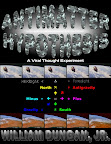The oldest, most evolved galaxies are elliptical galaxies, which contain old stars but little interstellar gas or dust. According to incumbent cosmologists, elliptical galaxies formed from merging galaxies, and dust bands around elliptical galaxies are the remains of collisions.




In the cyclical cellular cosmological model the dust bands around elliptical galaxies are the remains of dust rims around spiral galaxies, which evolved into elliptical galaxies nurtured from the inside-out.

A jet at the core of an elliptical galaxy indicates that the jet process that produces spiral galaxies also produces elliptical galaxies. Elliptical galaxies evolve from spiral galaxies.
 P. Crane (European Southern Observatory), and NASA/ESA
P. Crane (European Southern Observatory), and NASA/ESAStars concentrate at the core of elliptical galaxies building from the inside-out. Hot young blue stars gorge on hydrogen protoplasm near the core of elliptical galaxy M32.
 M32: Tod R. Lauer/NASA
M32: Tod R. Lauer/NASA NASA and Thomas M. Brown, Charles W. Bowers, Randy A. Kimble, Allen V. Sweigart (NASA Goddard Space Flight Center) and Henry C. Ferguson (Space Telescope Science Institute)
NASA and Thomas M. Brown, Charles W. Bowers, Randy A. Kimble, Allen V. Sweigart (NASA Goddard Space Flight Center) and Henry C. Ferguson (Space Telescope Science Institute)Young star clusters harvest the hydrogen protoplasm dissipating from the center of an old elliptical galaxy.

When jets build up enough resistance near the parent black hole, the hydrogen protoplasm is deflected away from the plane of the disk, and form a disk bulge. The disk bulge grows and disk galaxies evolve into elliptical galaxies.
 Roeland P. van der Marel (STScI), Frank C. van den Bosch (Univ. of Washington), and NASA
Roeland P. van der Marel (STScI), Frank C. van den Bosch (Univ. of Washington), and NASA NASA, Gerald Cecil (University of North Carolina), Sylvain Veilleux (University of Maryland), Joss Bland-Hawthorn (Anglo-Australian Observatory), and Alex Filippenko (University of California at Berkeley)
NASA, Gerald Cecil (University of North Carolina), Sylvain Veilleux (University of Maryland), Joss Bland-Hawthorn (Anglo-Australian Observatory), and Alex Filippenko (University of California at Berkeley) NASA and Jeffrey Kenney and Elizabeth Yale (Yale University)
NASA and Jeffrey Kenney and Elizabeth Yale (Yale University) NASA, W. Keel (University of Alabama), M. Ledlow (Gemini Observatory), F. Owen (NRAO) and AUI/NSF
NASA, W. Keel (University of Alabama), M. Ledlow (Gemini Observatory), F. Owen (NRAO) and AUI/NSF NASA, Gemini Observatory and W. Keel (University of Alabama, Tuscaloosa)
NASA, Gemini Observatory and W. Keel (University of Alabama, Tuscaloosa)























No comments:
Post a Comment